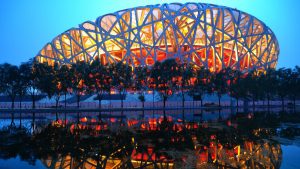Tensile Structures: A Revolution in Architecture
Tensile structures are a type of construction that uses a fabric membrane held in tension by cables or other structural elements. They are lightweight, strong, and versatile, and can be used to create a wide variety of shapes and forms. Tensile structures are becoming increasingly popular in architecture, as they offer several advantages over traditional construction methods.
How Tensile Structures Work
Tensile structures work by transferring loads to the supporting cables or other elements. The fabric membrane is placed under tension, which means that it is pulled tight in all directions. This creates a strong and stable structure that can withstand a variety of loads, including wind, snow, and rain.
Benefits of Tensile Structures
Tensile structures offer several benefits over traditional construction methods, including:
Lightweight: Tensile structures are much lighter than traditional structures made of concrete or steel. This makes them easier to transport and erect and can also reduce the cost of foundations.
Strong: Tensile structures are extraordinarily strong and can withstand a variety of loads. They are also well-suited for use in seismic zones.
Versatile: Tensile structures can be used to create a wide variety of shapes and forms, from simple canopies to complex domes and stadiums.
Cost-effective: Tensile structures can be more cost-effective than traditional construction methods, especially for large projects.
Sustainable: Tensile structures can be made from sustainable materials, such as recycled plastics and fabrics. They can also be designed to be energy-efficient and reduce the need for artificial lighting and cooling.
Examples of Tensile Structures Around the World
There are many examples of tensile structures around the world, used for a variety of purposes. Here are a few notable examples:
Bird’s Nest Stadium, Beijing, China: The Bird’s Nest Stadium was built for the 2008 Summer Olympics. It is a massive tensile structure that can seat over 90, 000 spectators.

https://www.westchinatour.com/beijing/attraction/birds-nest.html
Eden Project, Cornwall, England: The Eden Project is a botanical garden that houses two giant biomes. The biomes are made from tensile structures that create a unique environment for plants worldwide.

https://havecamerawilltravel.com/places/sydney-opera-house-australia-photos/
Denver International Airport, Denver, Colorado, USA: The Denver International Airport has a massive tensile roof that covers the entire main terminal.
The roof is one of the largest of its kind in the world.
Conclusion
Tensile structures are a revolutionary new type of construction that is becoming increasingly popular in architecture. They offer several advantages over traditional construction methods, including lightness, strength, versatility, and cost-effectiveness. Tensile structures can be used to create a wide variety of shapes and forms, making them ideal for a variety of purposes.
Tensile structures are versatile and innovative construction technology that is changing the way we build. As the technology continues to develop, we can expect to see even more impressive and creative tensile structures in the future.


